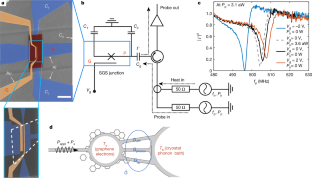(New detector breakthrough pushes boundaries of quantum computing)
2020/9/30 フィンランド・アールト大学

・ アールト大学とフィンランド技術研究センター(VTT)が、量子コンピューターで量子ビット(q ビット)のエネルギーを測定する、グラフェン製のボロメーターを開発。
・ ボロメーターは、入射するエネルギーを自身が受ける熱の量を通じて測定する検出器で、量子技術分野では q ビットからの量子情報の読み出しが最初のアプリケーションとされている。
・ q ビットのエネルギーの測定は、量子コンピューターの作動で極めて重要。現在は q ビットの引き起こす電圧を計測してそのエネルギー状態を測定している。
・ しかし、電圧の計測には大がかりな増幅回路が必要なため量子コンピューターのスケーラビリティーを制限すること、同増幅回路が大量に電力を消費すること、そして、電圧計測には q ビットの読み出しでエラーの原因となる量子ノイズが伴う、という 3 つの課題がある。ボロメーターを用いた q ビットエネルギーの測定により、これらの全課題の解決を試みた。
・ 過去に開発した金-パラジウム合金製のボロメーターのノイズレベルは極めて低かったが、量子コンピューターで q ビットを計測するのには遅すぎた。今回のブレイクスルーは、材料にグラフェンを使用することで達成。
・ グラフェンは熱容量が極めて低く、エネルギーの微量な変化も迅速に検知できる。このような検知能力が q ビットの測定や実験的な量子システムのアプリケーションに向けたボロメーターに最適となる。同グラフェンボロメーターは、既存の q ビット測定技術に匹敵する、1 マイクロ秒を下回る速度での計測が可能。
・ また、既存技術ではハイゼンベルクの不確定性原理による制限のため、電圧測定での量子ノイズの発生が不可避であるが、グラフェンボロメーターにはこの問題が無い。
・ 次には、グラフェンボロメーターによる最小のエネルギーパケットのリアルタイム解析と、量子技術の他に量子物理学の基礎的理解にも貢献する、マイクロ波光子の量子特性の計測を実施する。
・ 本研究に関わる科学者らの多くは、アールト大学のスピンアウトで量子コンピューター技術を開発する IQM に所属している。
・ 本共同研究は、Center of Excellence in Quantum Technology(QTF)および BOLOSE センサー開発プロジェクトの一環で、フィンランド・アカデミー(AF)が資金を提供した。アールト大学研究チームはまた、Horizon 2020 が資金を提供する、欧州委員会による Quantum Flagship の QMICS プロジェクトにも所属している。
URL: https://www.aalto.fi/en/news/new-detector-breakthrough-pushes-boundaries-of-quantumcomputing
<NEDO海外技術情報より>
(関連情報)
Nature 掲載論文(アブストラクトのみ:全文は有料)
Bolometer operating at the threshold for circuit quantum electrodynamics
URL: https://www.nature.com/articles/s41586-020-2753-3
Abstract
Radiation sensors based on the heating effect of absorbed radiation are typically simple to operate and flexible in terms of input frequency, so they are widely used in gas detection1, security2, terahertz imaging3, astrophysical observations4 and medical applications5. Several important applications are currently emerging from quantum technology and especially from electrical circuits that behave quantum mechanically, that is, circuit quantum electrodynamics6. This field has given rise to single-photon microwave detectors7,8,9 and a quantum computer that is superior to classical supercomputers for certain tasks10. Thermal sensors hold potential for enhancing such devices because they do not add quantum noise and they are smaller, simpler and consume about six orders of magnitude less power than the frequently used travelling-wave parametric amplifiers11. However, despite great progress in the speed12 and noise levels13 of thermal sensors, no bolometer has previously met the threshold for circuit quantum electrodynamics, which lies at a time constant of a few hundred nanoseconds and a simultaneous energy resolution of the order of 10h gigahertz (where h is the Planck constant). Here we experimentally demonstrate a bolometer that operates at this threshold, with a noise-equivalent power of 30 zeptowatts per square-root hertz, comparable to the lowest value reported so far13, at a thermal time constant two orders of magnitude shorter, at 500 nanoseconds. Both of these values are measured directly on the same device, giving an accurate estimation of 30h gigahertz for the calorimetric energy resolution. These improvements stem from the use of a graphene monolayer with extremely low specific heat14 as the active material. The minimum observed time constant of 200 nanoseconds is well below the dephasing times of roughly 100 microseconds reported for superconducting qubits15 and matches the timescales of currently used readout schemes16,17, thus enabling circuit quantum electrodynamics applications for bolometers.



